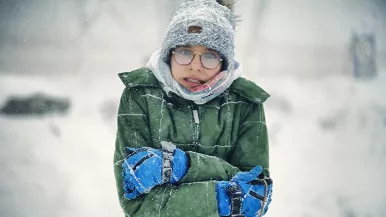In extremely cold, snowy and windy conditions, your safest option is to stay indoors. But if you do head outside, take precautions to avoid frostbite and hypothermia.
“Subzero temperatures can freeze exposed skin and underlying tissue, and frostbite can occur within minutes, before you may realize it," says Corey Goldstein, MD, an emergency medicine physician at Rush University Medical Center.
"Also, the very young and old, and those with cardiac conditions, need to be especially careful to avoid hypothermia, which occurs when your core body temperature drops below 95 degrees."
If you must go out, consider the following tips to prevent hypothermia and frostbite:
Cold weather safety tips
- Wear multiple layers of loose, warm clothing. In addition to keeping you warm, additional layers allow you to remove clothing that gets wet.
- Pay special attention to keeping head, hands, ears and feet warm and dry. Keeping your head warm helps your body retain heat, and fingers, toes and ears are the most vulnerable to frostbite.
- Choose boots that will keep your feet both warm and dry and a hat that covers your ears as well as the top of your head.
- Don’t text or use your phone outdoors in very cold temperatures or snow; and don’t choose gloves that have “half fingers” or are thin enough for texting.
- Get out of the cold immediately if you feel numbness or stinging on your skin or in your fingers or feet.
- Likewise, get out of the cold if you begin shivering to avoid hypothermia. Once hypothermia sets in, symptoms include persistent shivering, stiff muscles and impaired physical coordination and may involve confusion or irritability.
What to do if you suspect frostbite
Similar to burns, there are different degrees of frostbite, Goldstein says.
“There are a lot of treatment similarities to burns that people should remember," he says. "Ideally, go to the nearest emergency department if you suspect frostbite."
Here's what he recommends:
- Rewarm the affected area gently and gradually by immersing it in warm — never hot — water.
- Do not rub the affected area.
- If after several minutes the area remains numb or has a grayish-yellow color, call your primary care provider, or visit an urgent care clinic or emergency room.
- In more severe cases, blisters or sores might develop; if they do, go to an emergency room.
What to do if you suspect hypothermia
- Move indoors immediately, remove any wet clothing and steadily get warm.
- Do not use hot water bottles, electric blankets or other thermal heat sources to rewarm.
- Immediately seek medical attention if shivering persists after several minutes or a person seems confused.
While colder temperatures may not seem too dangerous at first, they can become hazardous quickly if you are not properly dressed or stay outside for too long. Being prepared and aware of your surroundings can prevent a scary situation when the temperature drops.
Snow Shoveling Safety Tips





